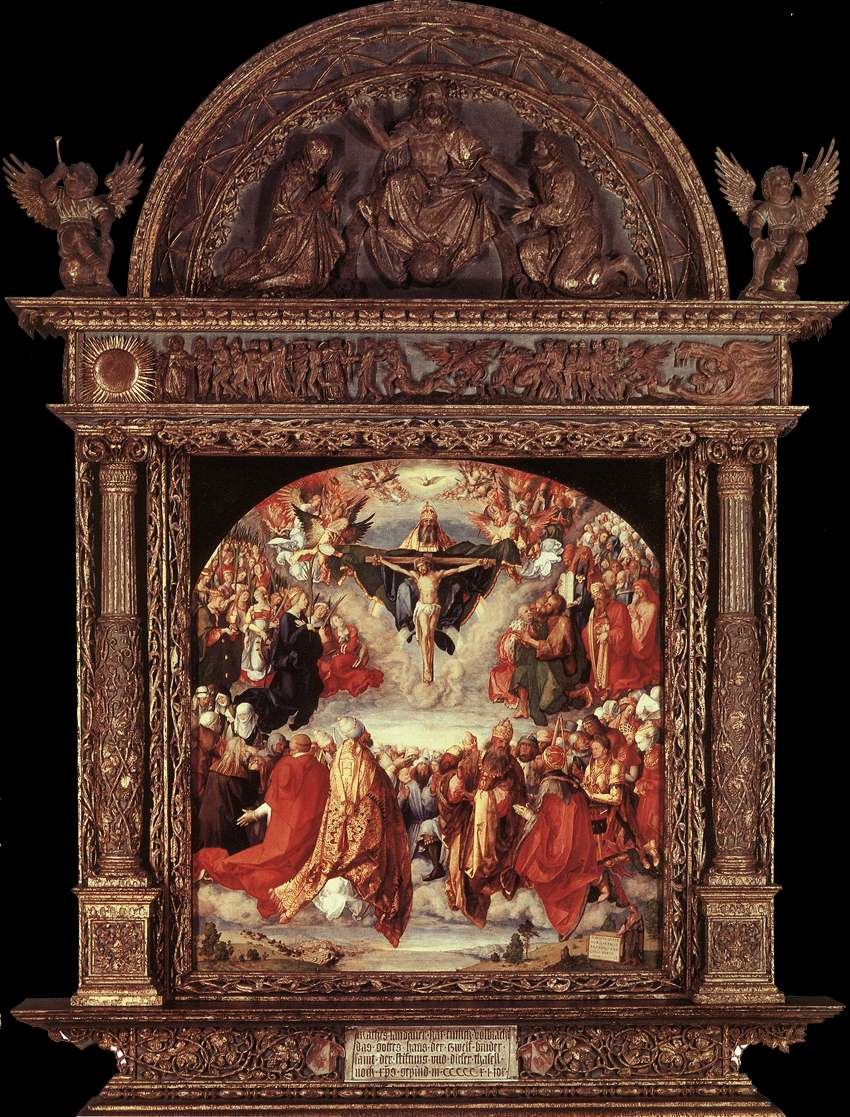Adoration of the Holy Trinity
7:00 AM |
| Albrecht Durer, Adoration of the Holy Trinity (Landauer Altarpiece), 1511 |
By LIBBY ROHR
Behold the majesty of one of Durer's later and greater works. Painted in 1511, begun shortly after his return from an extended trip to Italy to study the works of the great southern masters, was completed over the course of arguable his four best years as an artist. Durer painted this work as an altarpiece to go in the chapel of the "House of 12 Brothers," a retirement home for aging artists donated by Nuremberg metal trader Matthaus Landauer. Due to the nature of this commission, he would have had to be particularly sure of his skill in this work to be presenting it to his most experienced peers. As he originally studied wooden engraving, he also carved the frame it originally existed in, though the two have been separated for quite a while now. The one it resides in now is an exact replica, but a replica nonetheless.
The frame itself depicts the last judgement in stunning, meticulous detail, in carved and painted wood. As in the painting itself, the focus of the frame is a trinity. In this case, the Christ figure atop a globe with the kneeling Virgin on his left and kneeling John the Baptist on the right. Their presence is announced by two cherubs on either side. The climbing vines that encircle the painting itself reflect a gorgeous delicacy and care that bleeds into the painting itself.
Originally in my selection, I chose this painting due to its color. What with centuries of fading, it may not be as brilliant as I can imagine it once to be, but in looking at the juxtaposition even in this particular rendering, it's clear that as magnificent as the color is, it would have been even more so when first painted. In this particular work, the contrast between the gold and dark green of the tapestry behind Christ and the crisp white of the clouds that surround him especially help to emphasize him. The vibrancy of Durer's reds, golds, greens, and pastel blues cannot be understated, although the bulk of his works are black and white engravings. This work in particular seems to glow.
The geometry in this work is particularly evident. First, the painting is divided in half vertically (through the line of Jesus's body on the cross, the figure of God, down through the split of the congregation below) and horizontally (splitting the realm of heaven from earth). In the heavenly half, Jesus embodies the trinity in the clear triangle that frames him on the cross, splitting the crowd of saints in two. In addition, much of this painting flows out in concentric hemispheres around the central dove above the head of the Lord. The first ring is that of holy golden light, followed by creatures with the bodies of doves and the faces of cherubs, then by the angels holding up the cross of Christ, then the clouds around the christ figure, and finally by those adoring his holiness.
The upper right congregation is that of the male Old Testament saints, most notably and visibly Moses and King David. To the left are the female New Testament saints carrying palm ferns lead by the Virgin Mary, clad in blue as always, looking to her son in absolute devotion. The bottom grouping are the earthly Christians. Front and center, the pope is clearly emphasized, clad in gold, body turned upwards in worship. To the left of this lower group, the older man being embraced by the bishop is that of the patron, Mr. Landauer. The remainder of this group are other notable figures like the emperor alongside ordinary religious men and women, suggesting the inclusion of the audience into this portion.
Below this is a short landscape of which he was particularly fond of painting in his earlier years as well as my favorite of his self portraits. Rather than simply signing this work, Durer placed a likeness of himself in a red turban next to a plaque announcing his name and the date. He appears to be showing off, quite proud of what he's just painted. And in this case, he should be. This painting effectively through work of the brush, unites heaven with earth visually and in the emotional response. When observing this masterpiece, one has never been closer to the realm of God.
0 comments